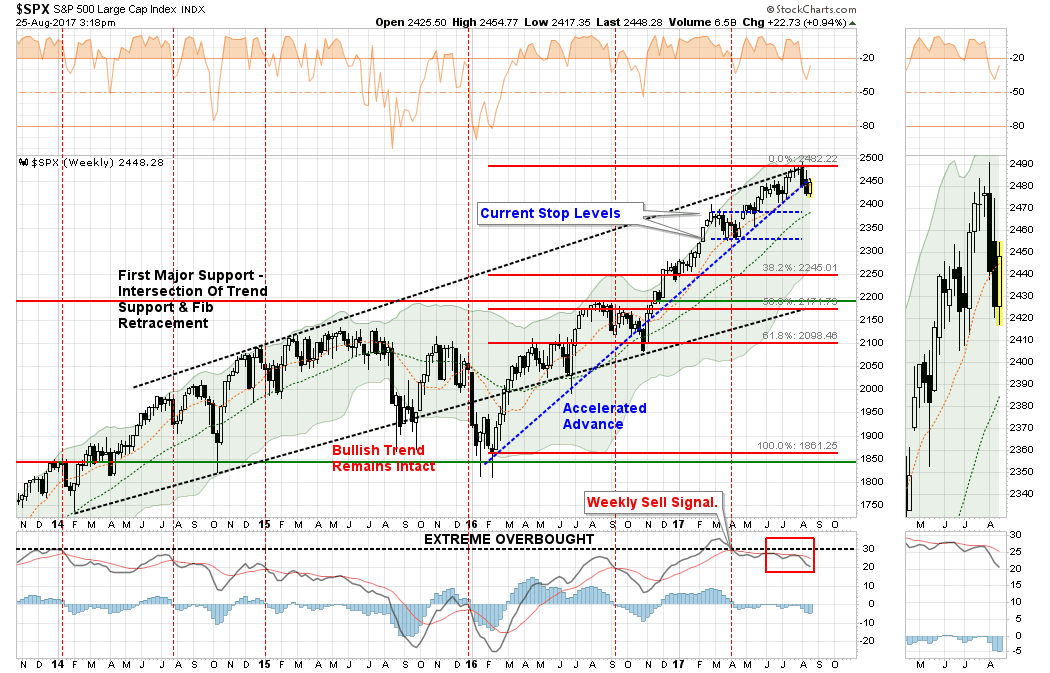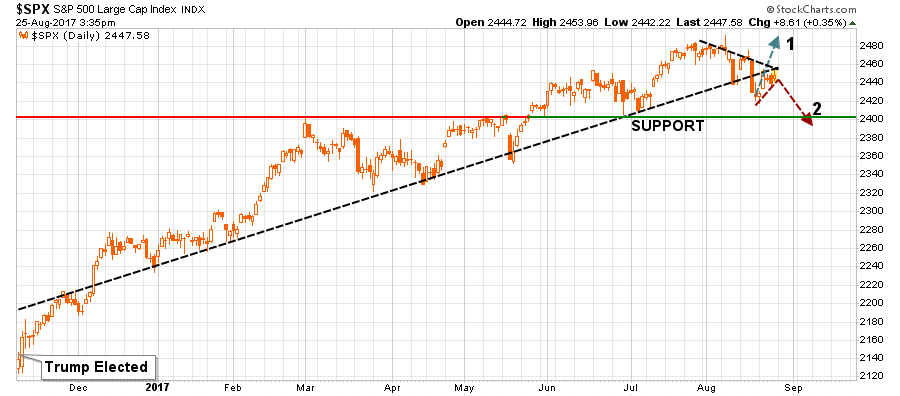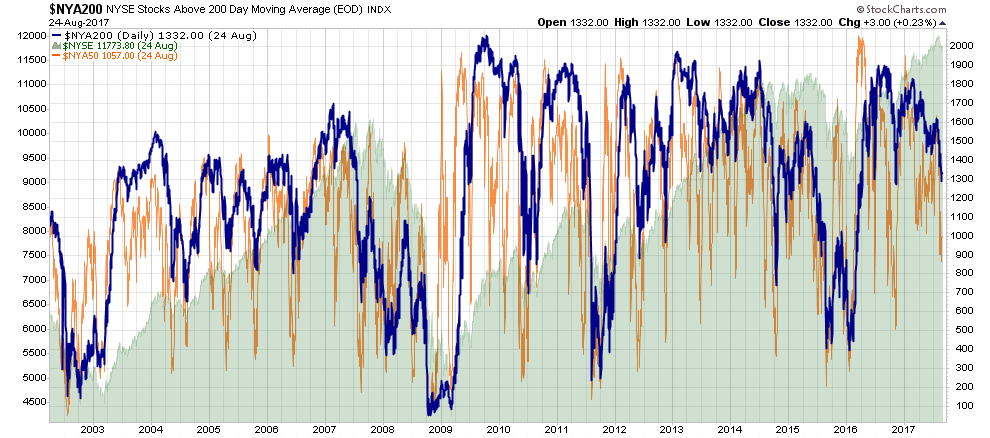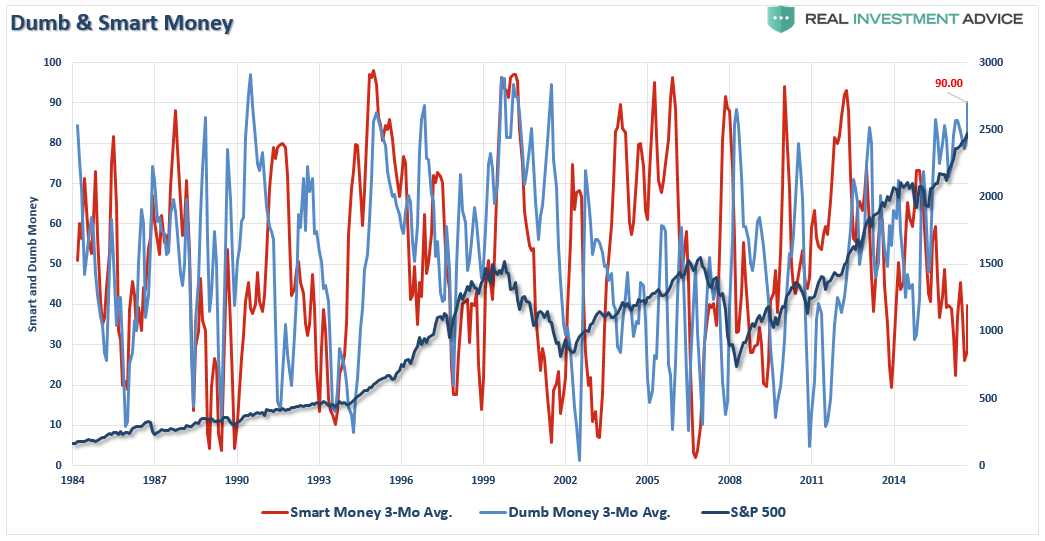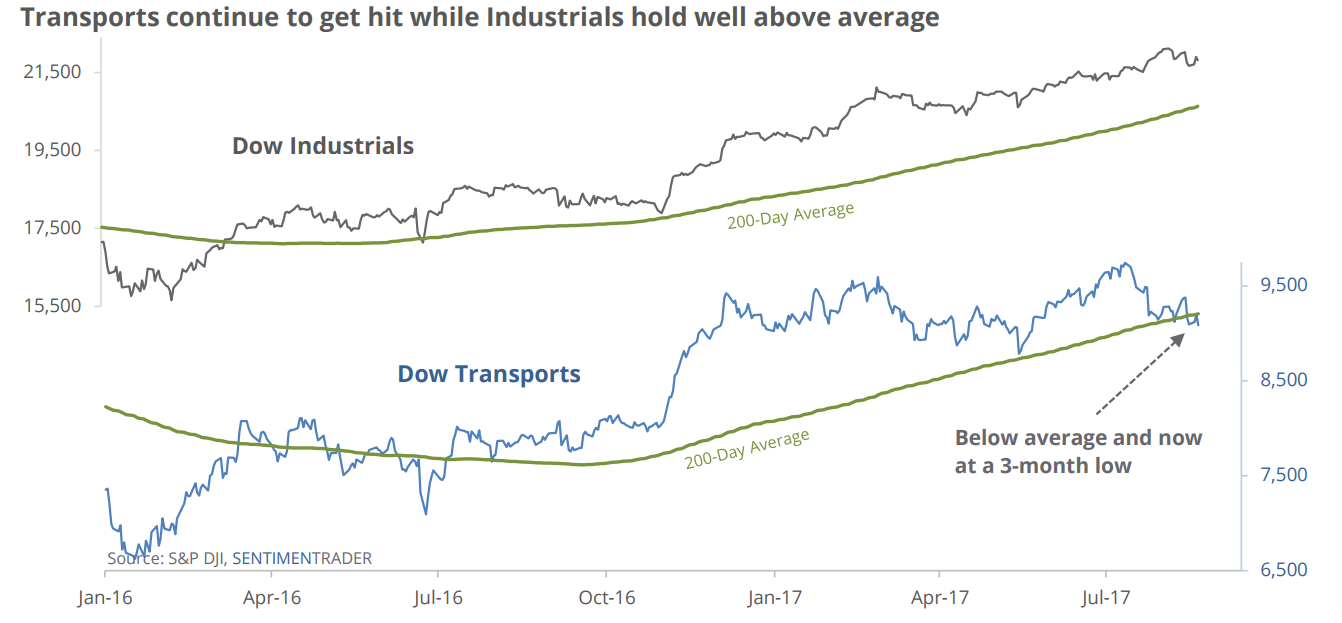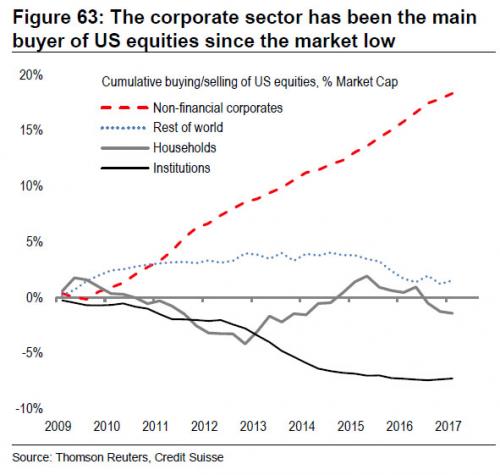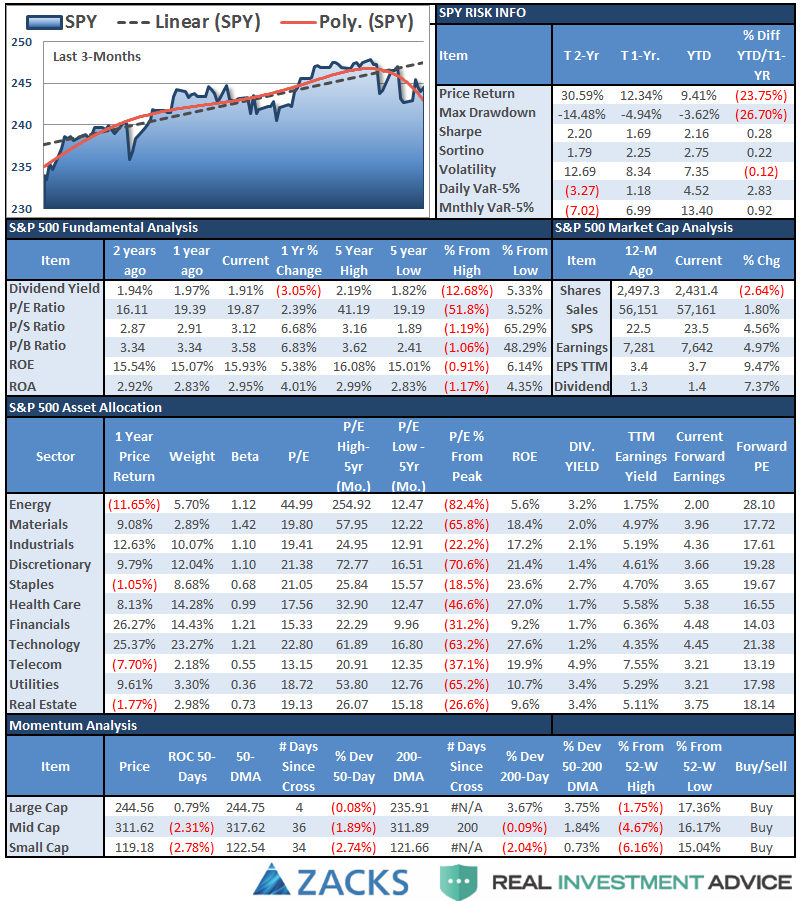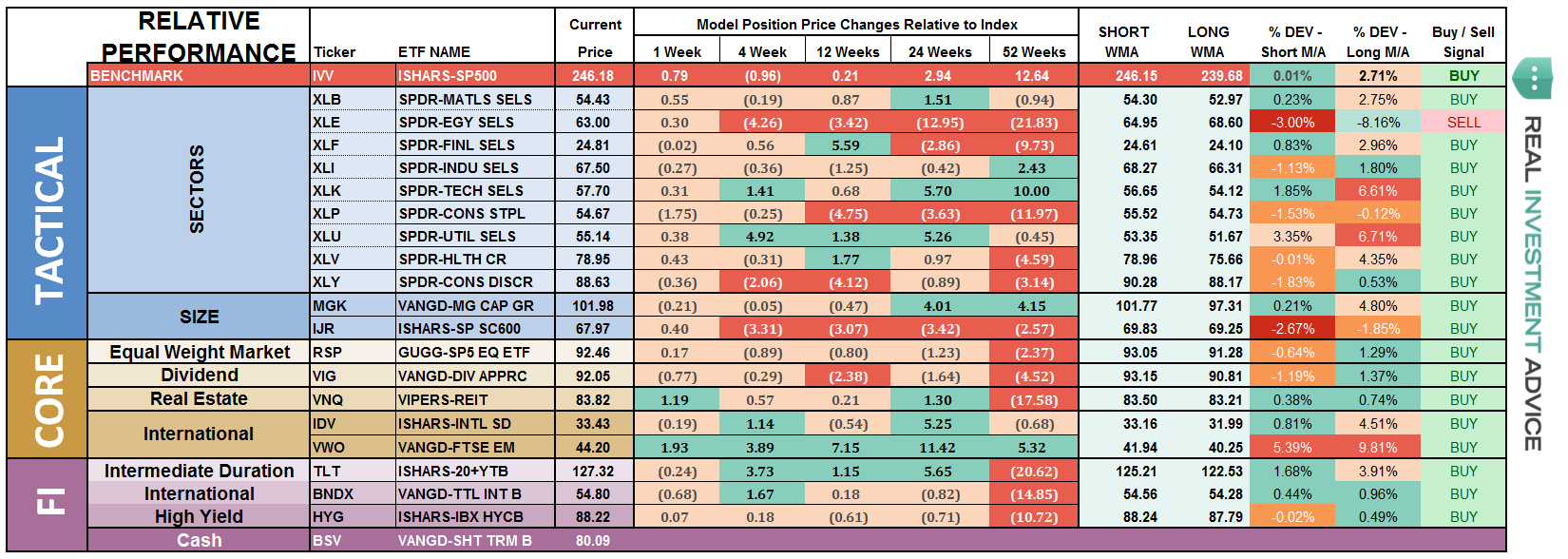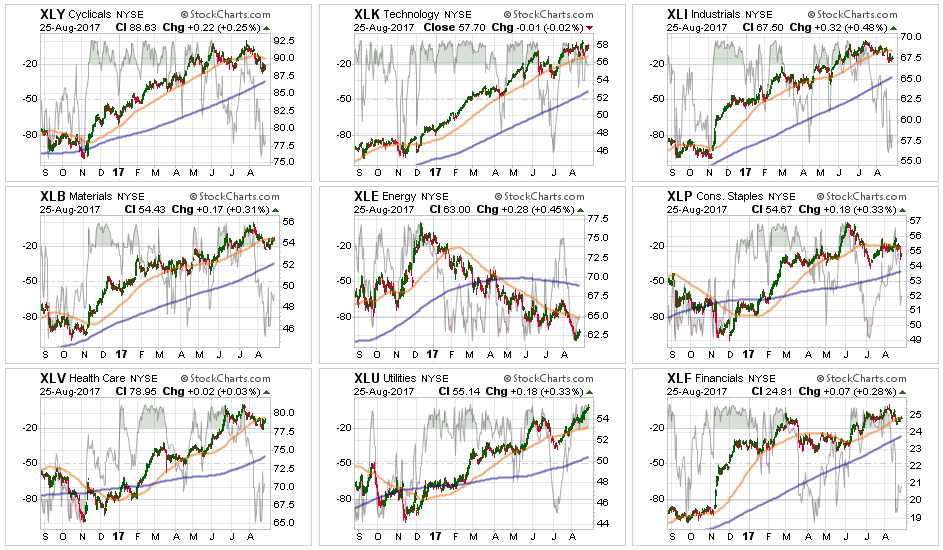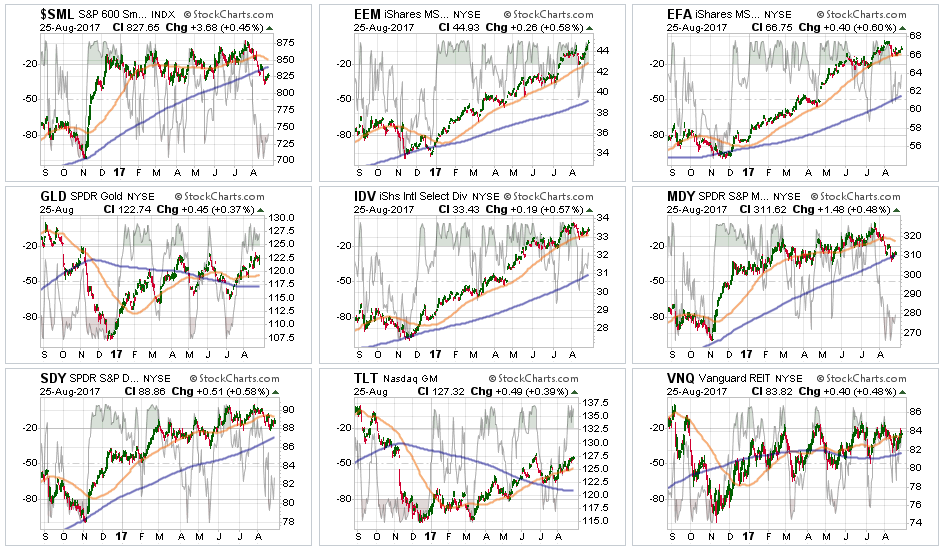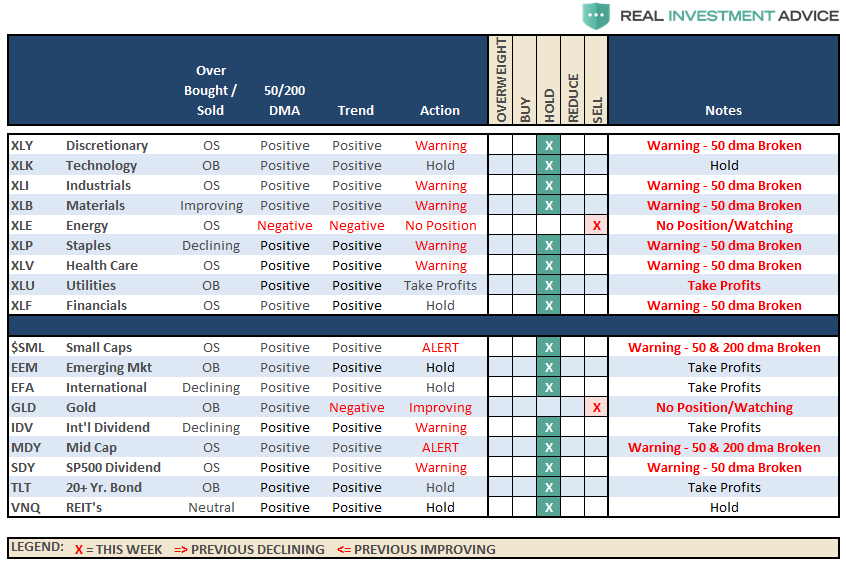As loyal readers are already aware, I live in Houston. Normally, during the month of August, temperatures tend to compete with the surface of the sun while rain tends to be a more random occurrence. In other words, there is little difference between Houston and the Sahara Desert, generally speaking.
This year, however, is a different story as we are preparing to deal with the impact of the first major hurricane (category-3) since Bret made landfall in 1999 and Alicia in 1983. (Ike, which hit the Texas coast in 2008 was only a category-2 storm.)
It is currently estimated that we will experience between 18 and 30-inches of rain which will also likely result in the loss of power. Therefore, this week’s newsletter is going to be a little brief so I can make sure and get it out to you beforehand.
Quick Review
“Exactly one week after last week’s S&P 500 sell off, the market dumped again. This time it was the news of the complete dismemberment of President Trump’s ‘economic council’ of CEO’s along with the rumor that Gary Cohn would be exiting his position at the White House as well. While the latter turned out to be #FakeNews, the damage had already been done as market participants began to question the ability of the Administration to get its promised legislative action advanced.
Given the run up in the markets since the election, which was based on tax cuts/reform, infrastructure spending, repatriation and repeal of the Affordable Care Act, the lack of progress on that agenda has left the markets pushing higher on ‘hope’ and ‘promises.’ The disbanding of the economic council has led to some disruption of that confidence.”
For the second week in a row, the market staged a strong comeback rally which again failed at resistance, keeping further additions to equities on hold once again this past week. With the market remaining on a short-term “sell signal,” we will remain patient to allow the market to regain a firmer footing within the confines of the current bullish trend.
On a weekly basis, the “bullish trend” remains at risk as well. With the markets on a weekly “sell signal” at fairly high levels, it does suggest that “stock slop” could be with us for a while, particularly as we head into the month of September. This potentially sets investors up for a bigger correction in the weeks ahead.
In case you missed last week’s missive, I laid out two scenarios we were watching while we “wait for confirmation the current sell-off has abated before adding additional risk exposure to portfolios.”
Scenario 1:
The market regains its footing this coming week and rallies strongly enough to break above the downward trending levels of previous rally attempts. Such action would confirm the bullish trend remains intact and would provide the opportunity to rebalance equity exposure to model weights accordingly.
Scenario 2:
The market rallies to the upwardly sloping “bullish trend line” that began with the election of President Trump. The rally fails at resistance and turns lower. Such a failure would confirm the current short-term bullish trend has likely concluded leading to a reduction of equity exposure, increases in cash positions and fixed income, and a reduction in overall portfolio equity risk.
It is “Scenario 2” which continues to play itself out currently.
The Case For “Scenario 2”
From an analytical viewpoint, there are several factors that continue to support “scenario 2,” as detailed above, playing out.
As noted, the internal deterioration of the market has continued unabated over the last several weeks, with the number of stocks trading above their respective 50- and 200-day moving averages dropping to levels that have more normally equated to a deeper market correction.
The internal deterioration in the market shouldn’t be surprising given the large outflows from equities over the last few weeks as noted recently by Joe Ciolli:
“Traders are dumping US stocks to a degree not seen in 13 years. They’ve pulled money out of US equity funds for 10 straight weeks, the longest such streak since 2004, according to data compiled by Bank of America Merrill Lynch.”
This doesn’t mean that stocks are imminently due for a crash, but the institutional (smart money) outflows from equities certainly put downward pressure on the “bull case” for the time being. However, with investors (dumb money) extremely long equities, as I noted two weeks ago, the case for substantially higher highs is quite limited.
Sentiment Trader also made an important observation in this regard as well with respect to the Dow indices being “out of gear.” To wit:
“When it comes to market clichés, theories, and indicators, people tend to have an almost religious adherence to minutia and forget the underlying principles behind them.
The Hindenburg Omen is a perfect example. The exact thresholds used to trigger the signal are seen as written in stone as if by some oracle, when we should instead be focused on the general conditions that show uptrending markets, losing underlying momentum, that are heavily split between winners and losers. The exact thresholds don’t matter.
Same with Dow Theory. There are strict adherents that require certain specific criteria, which is preposterous. Instead, we should just be concerned whether Industrial and Transportation stocks are in gear…or not. When they are, markets do well; when they aren’t, they don’t.
And right now, they’re not.”
Here is the important point:
“The Dow indexes are out of gear. The Dow Transportation Average continues to badly lag its brother index, the Dow Industrial Average. The Transports are not only below their 200-day average, they just dropped to a fresh multi-month low. Yet the Industrials are more than 5% above their own 200-day average, a divergence which has tended to resolve to the downside for both indexes, especially in the shorter term.”
Another major concern is the slide in corporate share buybacks. Buybacks have been one of the biggest supports of the bull market which was directly fueled by the Federal Reserve’s ultra-low interest policy and a flood of liquidity. As noted recently by Zerohedge:
“Share buybacks have slumped by over 20% YoY. Ominously, this is the sharpest drop in corporate buybacks since the financial crisis effectively shut down bond markets in 2008, as a result of the market no longer rewarding companies that lever up just to repurchase their own stock.”
“In fact, according to a chart from Credit Suisse, Fink may be more correct than he even knows. As CS’ strategist Andrew Garthwaite writes, ‘one of the major features of the US equity market since the low in 2009 is that the US corporate sector has bought 18% of market cap, while institutions have sold 7% of market cap.’
What this means is that since the financial crisis, there has been only one buyer of stocks: the companies themselves, who have engaged in the greatest debt-funded buyback spree in history.”
With the Trump Administration about to have a “crash course” in Washington politics when he has to deal with both a budget and a debt ceiling debate in the next couple of weeks, the realities of passing tax legislation to support current earnings and valuation levels are becoming much less likely. Furthermore, as I noted on Friday:
“The REAL problem with a government shutdown is it will serve as another distraction to keep the current Administration off of their primary task of passing their legislative agenda of tax reform, cuts, infrastructure spending and immigration reform. As I have stated many times previously, this is one of the biggest risks to the markets currently.”
With legislative agenda stalled AND stock buybacks declining, this is going to weigh on the marginal earnings growth that has been inflated through the reduction is shares outstanding. As Strategas points out, Wall Street is not preparing for the decline in EPS that is coming.
“Last year’s easy comps become this year’s tougher comps starting now, so the natural progression is for the growth rate to slow. Adjusting prevailing estimates for the historical revision baseline, which is negative, shows earnings growth falling to mid-single digits rates by next year.
This is not to say earnings will begin to decline straightaway, but they will mathematically increase at a decreasing rate. This progression is typical of a late-cycle profit re-acceleration running out of steam.”
Don’t get all depressed. These are just things you NEED to be paying attention to.
The good news is that on a VERY short-term basis, the markets are oversold enough to garner a bounce this coming week. Given the points above, that bounce will need to be strong enough to reverse the negative trends currently running through the markets. The last time the market broke the 50-dma, and failed to reclaim it in a very short-period, it led to a much deeper correction heading into the Presidential election.
Based on the current backdrop, I continue to recommend, again this week, that investors should take some actions in rebalancing portfolio risks accordingly.
- Tighten up stop-loss levels to current support levels for each position.
- Hedge portfolios against major market declines.
- Take profits in positions that have been big winners
- Sell laggards and losers
- Raise cash and rebalance portfolios to target weightings.
This doesn’t mean “sell everything” and run into cash. It simply means pay attention to your exposure and have a plan in place in case something goes wrong.
See you next week.
Market and Sector Analysis
Data Analysis Of The Market and Sectors For Traders
S&P 500 Tear Sheet
Performance Analysis
ETF Model Relative Performance Analysis
Sector and Market Analysis:
This past week, as noted above, the markets lost ground as concerns over the legislative agenda arose. With the S&P 500 having broken its post-election uptrend and the 50-dma, concerns over the stability of the current bull market are rising.
Utilities, Materials, Financials, Health Care and Technology were the best performers this week relative to the S&P 500 index itself, but that’s not saying a whole lot outside of Utilities which caught the bulk of the “safety” trade.Industrials, Discretionary and Staples were weaker on a relative basis and remain below their respective 50-day moving averages putting each sector on “alert” status. While bullish trends remain intact, those trends are coming under attack so it is important to tighten up stop levels, watch sector rotation and leadership changes.
Energy, despite a small bounce in the sector, the trends and backdrop remain sorely negative. Not only did oil prices not hold $48/bbl, energy stocks blasted to new lows last week and remain close to those lows currently. We continue to remain out of the sector entirely.
Small and Mid-Cap stocks remained weak but the sectors are now deeply oversold. We are looking for a failed bounce to exit positions and raise cash. The violation of monthly support suggests more trouble ahead, but we will opportunistically look for a reasonable exit.
Emerging Markets and International Stocks continue to hold support and money has been chasing performance in these sectors as of late. Continue to hold positions for now.
Gold – was unable to break out of its trading range last week and is once again very overbought. We will watch for further developments in the coming week.
S&P Dividend Stocks (IDV, SDY), after adding some additional exposure recently we are holding our positions for now with stops moved up to recent lows. While the sector remained below its 50-dma it is currently holding support while having become oversold. We could be afforded an entry point if the market firms up.
Bonds and REITs continued to perform well last week as money rotated from “risk” into “safety.” Hold current positions for now.
Sector Recommendations:
The table below shows thoughts on specific actions related to the current market environment.(These are not recommendations or solicitations to take any action. This is for informational purposes only related to market extremes and contrarian positioning within portfolios. Use at your own risk and peril.)
Portfolio Update:
As noted above, while the overall bullish trend remains positive which keeps our portfolios allocated toward equity risk, the deterioration of the primary supports of the market remain concerning. While warnings are just that, a warning, it does suggest a bigger correction may be in the works over the next month, or so.
Stops have been raised to trailing support levels and we continue to look for ways to “de-risk” portfolios at this late stage of a bull market advance.
We remain invested but are becoming highly concerned about the underlying risk.
- English (UK)
- English (India)
- English (Canada)
- English (Australia)
- English (South Africa)
- English (Philippines)
- English (Nigeria)
- Deutsch
- Español (España)
- Español (México)
- Français
- Italiano
- Nederlands
- Português (Portugal)
- Polski
- Português (Brasil)
- Русский
- Türkçe
- العربية
- Ελληνικά
- Svenska
- Suomi
- עברית
- 日本語
- 한국어
- 简体中文
- 繁體中文
- Bahasa Indonesia
- Bahasa Melayu
- ไทย
- Tiếng Việt
- हिंदी
Market On Short-Term Sell Signal With Bullish Trend At Risk
Published 08/27/2017, 01:52 AM
Updated 02/15/2024, 03:10 AM
Market On Short-Term Sell Signal With Bullish Trend At Risk
3rd party Ad. Not an offer or recommendation by Investing.com. See disclosure here or
remove ads
.
Latest comments
Amazing analysis. Thank you, Lance.
Install Our App
Risk Disclosure: Trading in financial instruments and/or cryptocurrencies involves high risks including the risk of losing some, or all, of your investment amount, and may not be suitable for all investors. Prices of cryptocurrencies are extremely volatile and may be affected by external factors such as financial, regulatory or political events. Trading on margin increases the financial risks.
Before deciding to trade in financial instrument or cryptocurrencies you should be fully informed of the risks and costs associated with trading the financial markets, carefully consider your investment objectives, level of experience, and risk appetite, and seek professional advice where needed.
Fusion Media would like to remind you that the data contained in this website is not necessarily real-time nor accurate. The data and prices on the website are not necessarily provided by any market or exchange, but may be provided by market makers, and so prices may not be accurate and may differ from the actual price at any given market, meaning prices are indicative and not appropriate for trading purposes. Fusion Media and any provider of the data contained in this website will not accept liability for any loss or damage as a result of your trading, or your reliance on the information contained within this website.
It is prohibited to use, store, reproduce, display, modify, transmit or distribute the data contained in this website without the explicit prior written permission of Fusion Media and/or the data provider. All intellectual property rights are reserved by the providers and/or the exchange providing the data contained in this website.
Fusion Media may be compensated by the advertisers that appear on the website, based on your interaction with the advertisements or advertisers.
Before deciding to trade in financial instrument or cryptocurrencies you should be fully informed of the risks and costs associated with trading the financial markets, carefully consider your investment objectives, level of experience, and risk appetite, and seek professional advice where needed.
Fusion Media would like to remind you that the data contained in this website is not necessarily real-time nor accurate. The data and prices on the website are not necessarily provided by any market or exchange, but may be provided by market makers, and so prices may not be accurate and may differ from the actual price at any given market, meaning prices are indicative and not appropriate for trading purposes. Fusion Media and any provider of the data contained in this website will not accept liability for any loss or damage as a result of your trading, or your reliance on the information contained within this website.
It is prohibited to use, store, reproduce, display, modify, transmit or distribute the data contained in this website without the explicit prior written permission of Fusion Media and/or the data provider. All intellectual property rights are reserved by the providers and/or the exchange providing the data contained in this website.
Fusion Media may be compensated by the advertisers that appear on the website, based on your interaction with the advertisements or advertisers.
© 2007-2024 - Fusion Media Limited. All Rights Reserved.


